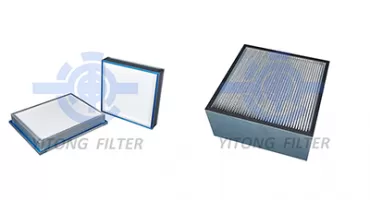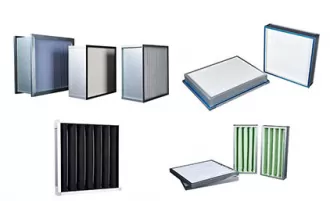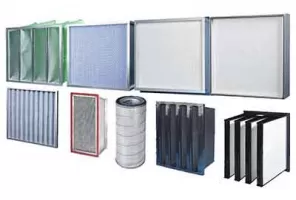 November 06, 2024
November 06, 2024
In industries where air purity is critical, the need for advanced filtration technology is essential. V-Bank filters have become a popular choice across various sectors because of their efficiency, energy savings, and long lifespan. From healthcare and food production to industrial manufacturing, these filters play a pivotal role in ensuring clean air, reducing energy costs, and prolonging the operational life of equipment.
This guide will provide a comprehensive look at what V-Bank filters are, how they work, their key advantages, and how to choose the right filter for your needs.
A V-Bank filter is a high-efficiency air filter with a distinctive V-shaped design. This unique shape allows it to maximize filter surface area without increasing the overall footprint. The V-Bank structure refers to the multiple V-shaped folds that hold layers of filter media. These folds allow for greater airflow and increase the filter's ability to trap more airborne contaminants.
Unlike traditional panel or bag filters, which are often limited in filtration area or efficiency, V-Bank filters offer high dust-holding capacity and longer service life. Their multi-layered design helps them achieve filtration efficiencies that meet the standards required for environments like hospitals, pharmaceutical labs, and manufacturing facilities.
V-Bank filters work by combining mechanical filtration and aerodynamic efficiency. When air enters the filter, it passes through multiple layers of the V-folded media. This media is often made from specialized synthetic fibers or fiberglass and is designed to trap tiny particles such as dust, pollen, bacteria, and mold spores.
Filtration Mechanism: V-Bank filters typically employ mechanical filtration, where particles are physically captured by the filter material. For finer particles, these filters can incorporate electrostatically charged fibers, which attract particles even as small as 0.3 microns.
V-Shaped Design: The V-shaped construction creates a large surface area within a compact frame. This maximizes airflow while reducing air resistance, which means that fans and ventilation systems require less energy to push air through the filter, lowering energy costs.
High Filtration Efficiency
V-Bank filters are designed to capture particles of varying sizes, making them highly efficient at trapping both large dust particles and microscopic pollutants. Many V-Bank filters achieve HEPA or ULPA-level filtration, which means they can remove up to 99.97% of particles as small as 0.3 microns, making them suitable for critical environments.
Energy Efficiency and Airflow
The V-Bank’s shape minimizes pressure drop, meaning less energy is required to move air through the filter. Reduced energy consumption is especially beneficial in large facilities where air filtration systems are in constant operation.
Longer Lifespan
With a high dust-holding capacity, V-Bank filters generally require fewer replacements than standard filters. This reduces maintenance time and costs, leading to fewer disruptions and a more consistent air quality standard.
Cost-Effective Over Time
Although they may have a higher upfront cost, V-Bank filters are economical in the long run. The energy savings, reduced maintenance needs, and extended replacement intervals make them a wise investment for facilities prioritizing both air quality and operational efficiency.
V-Bank filters are used in a wide range of environments, especially those that demand high levels of air purity.
Healthcare Facilities: Hospitals and clinics rely on these filters to reduce airborne pathogens, ensuring clean air in critical areas like operating rooms and intensive care units.
Food Processing and Preparation: Food safety regulations often require environments free from contaminants. V-Bank filters can help maintain the necessary standards by removing particles that may compromise food quality.
Electronics and Pharmaceutical Manufacturing: In industries where small particles can damage products or interfere with production processes, V-Bank filters provide the ultra-clean air needed for safe and precise operations.
Commercial Buildings and Cleanrooms: For general commercial use, V-Bank filters ensure a healthier indoor environment by reducing allergens, dust, and pollutants.
When choosing a V-Bank filter, several factors must be considered to ensure it meets the demands of your specific environment:
Size and Dimensions
The filter must fit the air handling system without causing gaps that could allow unfiltered air to bypass.
Filter Material
Look for durable, efficient materials, like synthetic fibers or fiberglass, that match your filtration needs. Some V-Bank filters also come with an antimicrobial treatment to inhibit bacterial growth.
Efficiency Rating
Filters are typically rated by MERV (Minimum Efficiency Reporting Value) for general use or HEPA/ULPA standards for more critical environments. Choose a rating that aligns with your required air quality level.
Maintenance and Replacement
Consider how often the filter will need to be replaced and factor this into your operating budget. V-Bank filters usually require less frequent replacements, but knowing the expected maintenance schedule can help with planning.
Compared to other filters, V-Bank filters offer unique advantages:
Panel Filters: While panel filters are affordable and easy to install, they generally provide lower filtration efficiency and have a shorter lifespan. They work well for less demanding environments but may fall short in areas needing high air purity.
Bag Filters: Bag filters can handle high dust loads and have a good lifespan, but they may restrict airflow more than V-Bank filters. For facilities needing constant airflow with minimal pressure drop, V-Bank filters may be the better choice.
HEPA Filters: V-Bank filters can reach HEPA-level efficiency while offering better airflow. However, in ultra-critical environments, standalone HEPA filters might still be preferable for the highest purification standards.
V-Bank filters offer a powerful combination of efficiency, longevity, and energy savings, making them an ideal choice for industries that demand clean air. Their unique V-shaped design allows for greater airflow and a larger filtration surface without sacrificing space or increasing energy costs. Whether in healthcare, manufacturing, or commercial applications, V-Bank filters deliver high-level air purification to create healthier and safer environments.
If you’re considering upgrading your filtration system, V-Bank filters are worth exploring for their long-term value and reliability. By investing in these high-performance filters, you’re not only improving air quality but also contributing to a more efficient and sustainable operation.
 Nov. 14, 2023
Enhancing Pharmaceutical Production: The Vital Role of HEPA Filters
Nov. 14, 2023
Enhancing Pharmaceutical Production: The Vital Role of HEPA Filters
 Jan. 25, 2025
Panel Air Filters: An Essential Guide to Cleaner Air
Jan. 25, 2025
Panel Air Filters: An Essential Guide to Cleaner Air
 Apr. 17, 2025
HVAC HEPA Filters: Everything You Need to Know
Apr. 17, 2025
HVAC HEPA Filters: Everything You Need to Know